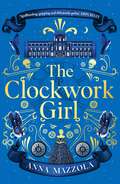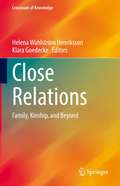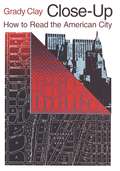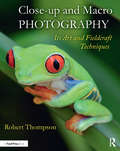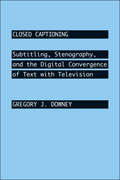- Table View
- List View
Clive James On Television: Television Criticism From The Observer 1972-1982
by Clive JamesFor the first time in one volume all Clive James's treasured TV criticism, originally written for The Observer between the years 1972 and 1982. From the 1972 Olympics to the 1982 Eurovision Song Contest, here is a decade of the most trenchant, witty and thought-provoking criticism of any kind, with a foreword from Clive James himself, described as 'the funniest man in Britain'.
The Clockwork Girl: The captivating and hotly-anticipated mystery you won’t want to miss in 2022!
by Anna Mazzola'Evocative, chilling, compelling' TAMMY COHEN'Breathtakingly good' ABIR MUKHERJEE'Kept me guessing until the end. An absolute masterpiece' JENNIFER SAINT'A deliciously dark historical novel of thrilling originality' ESSIE FOX'Spellbinding, gripping, immersive and deliciously gothic' ERIN KELLYParis, 1750.In the midst of an icy winter, as birds fall frozen from the sky, chambermaid Madeleine Chastel arrives at the home of the city's celebrated clockmaker and his clever, unworldly daughter. Madeleine is hiding a dark past, and a dangerous purpose: to discover the truth of the clockmaker's experiments and record his every move, in exchange for her own chance of freedom.For as children quietly vanish from the Parisian streets, rumours are swirling that the clockmaker's intricate mechanical creations, bejewelled birds and silver spiders, are more than they seem.And soon Madeleine fears that she has stumbled upon an even greater conspiracy. One which might reach to the very heart of Versailles...A intoxicating story of obsession, illusion and the price of freedom.
A Clockwork Orange (Controversies)
by Peter KramerDrawing on new research in the Stanley Kubrick Archive at the University of the Arts London, Krämer's study explores the production, marketing and reception as well as the themes and style of A Clockwork Orange against the backdrop of Kubrick's previous work and of wider developments in cinema, culture and society from the 1950s to the early 1970s.
A Clockwork Orange (Controversies)
by Peter KramerDrawing on new research in the Stanley Kubrick Archive at the University of the Arts London, Krämer's study explores the production, marketing and reception as well as the themes and style of A Clockwork Orange against the backdrop of Kubrick's previous work and of wider developments in cinema, culture and society from the 1950s to the early 1970s.
Cloning Terror: The War of Images, 9/11 to the Present
by W. J. MitchellThe phrase “War on Terror” has quietly been retired from official usage, but it persists in the American psyche, and our understanding of it is hardly complete. Nor will it be, W. J. T Mitchell argues, without a grasp of the images that it spawned, and that spawned it. Exploring the role of verbal and visual images in the War on Terror, Mitchell finds a conflict whose shaky metaphoric and imaginary conception has created its own reality. At the same time, Mitchell locates in the concept of clones and cloning an anxiety about new forms of image-making that has amplified the political effects of the War on Terror. Cloning and terror, he argues, share an uncanny structural resemblance, shuttling back and forth between imaginary and real, metaphoric and literal manifestations. In Mitchell’s startling analysis, cloning terror emerges as the inevitable metaphor for the way in which the War on Terror has not only helped recruit more fighters to the jihadist cause but undermined the American constitution with “faith-based” foreign and domestic policies. Bringing together the hooded prisoners of Abu Ghraib with the cloned stormtroopers of the Star Wars saga, Mitchell draws attention to the figures of faceless anonymity that stalk the ever-shifting and unlocatable “fronts” of the War on Terror. A striking new investigation of the role of images from our foremost scholar of iconology, Cloning Terror will expand our understanding of the visual legacy of a new kind of war and reframe our understanding of contemporary biopower and biopolitics.
Cloning Terror: The War of Images, 9/11 to the Present
by W. J. MitchellThe phrase “War on Terror” has quietly been retired from official usage, but it persists in the American psyche, and our understanding of it is hardly complete. Nor will it be, W. J. T Mitchell argues, without a grasp of the images that it spawned, and that spawned it. Exploring the role of verbal and visual images in the War on Terror, Mitchell finds a conflict whose shaky metaphoric and imaginary conception has created its own reality. At the same time, Mitchell locates in the concept of clones and cloning an anxiety about new forms of image-making that has amplified the political effects of the War on Terror. Cloning and terror, he argues, share an uncanny structural resemblance, shuttling back and forth between imaginary and real, metaphoric and literal manifestations. In Mitchell’s startling analysis, cloning terror emerges as the inevitable metaphor for the way in which the War on Terror has not only helped recruit more fighters to the jihadist cause but undermined the American constitution with “faith-based” foreign and domestic policies. Bringing together the hooded prisoners of Abu Ghraib with the cloned stormtroopers of the Star Wars saga, Mitchell draws attention to the figures of faceless anonymity that stalk the ever-shifting and unlocatable “fronts” of the War on Terror. A striking new investigation of the role of images from our foremost scholar of iconology, Cloning Terror will expand our understanding of the visual legacy of a new kind of war and reframe our understanding of contemporary biopower and biopolitics.
Cloning Terror: The War of Images, 9/11 to the Present
by W. J. MitchellThe phrase “War on Terror” has quietly been retired from official usage, but it persists in the American psyche, and our understanding of it is hardly complete. Nor will it be, W. J. T Mitchell argues, without a grasp of the images that it spawned, and that spawned it. Exploring the role of verbal and visual images in the War on Terror, Mitchell finds a conflict whose shaky metaphoric and imaginary conception has created its own reality. At the same time, Mitchell locates in the concept of clones and cloning an anxiety about new forms of image-making that has amplified the political effects of the War on Terror. Cloning and terror, he argues, share an uncanny structural resemblance, shuttling back and forth between imaginary and real, metaphoric and literal manifestations. In Mitchell’s startling analysis, cloning terror emerges as the inevitable metaphor for the way in which the War on Terror has not only helped recruit more fighters to the jihadist cause but undermined the American constitution with “faith-based” foreign and domestic policies. Bringing together the hooded prisoners of Abu Ghraib with the cloned stormtroopers of the Star Wars saga, Mitchell draws attention to the figures of faceless anonymity that stalk the ever-shifting and unlocatable “fronts” of the War on Terror. A striking new investigation of the role of images from our foremost scholar of iconology, Cloning Terror will expand our understanding of the visual legacy of a new kind of war and reframe our understanding of contemporary biopower and biopolitics.
Close Encounters of Art and Physics: An Artist's View
by Laura PesceClose Encounters of Art and Physics is a voyage in time through the abstract ideas harboured in the minds of humans, starting from the graffiti art of cave dwellers and extending to the street art of contemporary men and women. In seeking parallels with science, the author looks far back to the first geometric ideas of our ancestors as well as ahead to the contemporary science of present-day physicists. The parallelism and analogies between these two fields bear witness to a real entanglement in the human brain. The second part of the book contains about 25 colour images showing the author's stunning glass artwork representing ideas such as dark matter, quantum entanglement, cellular automata and many others that are almost impossible to capture in words. Furthermore, many of the physicists who have themselves made major contributions in these fields provide their comments and analysis of the works. The book provides entertaining and informative reading, not only for practicing artists and physicists, but also anyone curious about art and physics.
Close Encounters of the Third Kind (BFI Film Classics)
by Dana PolanSteven Spielberg's Close Encounters of the Third Kind (1977) is a film very much of its cinematic moment, combining the gritty realism of entrapment in the everyday with furtive dreams of escape. Dana Polan's compelling study of the film examines its significance to New Hollywood cinema and the science fiction genre. He argues that Close Encounters is a film that is an allegory of the cinematic experience overall; it both narrates a tale of visual seduction and plays it out viscerally for the spectator who shares the amazement of the protagonist Roy Neary as his mundane reality is transformed into something awe-inspiring. Providing an in-depth look into the film's production history, including all three different versions, Polan situates Close Encounters within Spielberg's repertoire. He argues that despite the film's popular success, it is in fact a rejection of several entrenched American values, including family, home and marriage. It offers, through its visual fascination, alternative understandings of masculinity and morality, familial responsibility, and what it means to follow the 'American Dream'.
Close Encounters of the Third Kind (BFI Film Classics)
by Dana PolanSteven Spielberg's Close Encounters of the Third Kind (1977) is a film very much of its cinematic moment, combining the gritty realism of entrapment in the everyday with furtive dreams of escape. Dana Polan's compelling study of the film examines its significance to New Hollywood cinema and the science fiction genre. He argues that Close Encounters is a film that is an allegory of the cinematic experience overall; it both narrates a tale of visual seduction and plays it out viscerally for the spectator who shares the amazement of the protagonist Roy Neary as his mundane reality is transformed into something awe-inspiring. Providing an in-depth look into the film's production history, including all three different versions, Polan situates Close Encounters within Spielberg's repertoire. He argues that despite the film's popular success, it is in fact a rejection of several entrenched American values, including family, home and marriage. It offers, through its visual fascination, alternative understandings of masculinity and morality, familial responsibility, and what it means to follow the 'American Dream'.
Close Relations: Family, Kinship, and Beyond (Crossroads of Knowledge)
by Helena Wahlström Henriksson Klara GoedeckeThis book speaks to the meanings and values that inhere in close relations, focusing on ‘family’ and ‘kinship’ but also looking beyond these categories. Multifaceted, diverse and subject to constant debate, close relations are ubiquitous in human lives on embodied as well as symbolic levels. Closely related to processes of power, legibility and recognition, close relations are surrounded by boundaries that both constrain and enable their practical, symbolical and legal formation. Carefully contextualising close relations in relation to different national contexts, but also in relation to gender, sexuality, race, religion and dis/ability, the volume points to the importance of and variations in how close relations are lived, understood and negotiated.Grounded in a number of academic areas and disciplines, ranging from legal studies, sociology and social work to literary studies and ethnology, this volume also highlights the value of using inter- and multidisciplinary scholarly approaches in research about close relations.Chapter 11 is available open access under a Creative Commons Attribution 4.0 International License via link.springer.com.
Close to the Enemy (Modern Plays)
by Stephen PoliakoffClose to the Enemy is a seven-part television series, mostly set in a bomb-damaged London hotel in the aftermath of the Second World War.The drama follows intelligence officer Captain Callum Ferguson whose last task for the Army is to ensure that a captured German scientist, Dieter, starts working for the British RAF on urgently developing the jet engine. With the background of the emerging Cold War, it is clear to all that it's crucial for British national security that cutting-edge technology is made available to the armed forces as quickly as possible. Callum uses unorthodox methods in his attempt to convince Dieter to work with the British and eventually a friendship develops between the two men, but soon tensions arise as all is not as it seems.Over the course of the series, Callum encounters a number of other characters whose stories all intertwine. These characters include Victor, Callum's younger brother, struggling to deal with psychological trauma caused by his experience in the fighting; Harold, a Foreign Office official who reveals some startling truths about the outbreak of the war; Rachel, an enchanting Anglophile American engaged to his best friend; and Kathy, a tough young woman working for the War Crimes Unit, fighting to bring war criminals who escaped prosecution to justice. All these characters are trying to rebuild and move their lives forward in the aftermath of the war, a war that scarred them all so deeply.Close to the Enemy was first screened on BBC2 in November 2016 in a production by Little Island Productions. It starred Jim Sturgess, Freddie Highmore, Charlotte Riley, Phoebe Fox, August Diehl, Robert Glenister, Alfie Allen, Charity Wakefield, Angela Bassett, Lindsay Duncan and Alfred Molina.
Close to the Enemy (Modern Plays)
by Stephen PoliakoffClose to the Enemy is a seven-part television series, mostly set in a bomb-damaged London hotel in the aftermath of the Second World War.The drama follows intelligence officer Captain Callum Ferguson whose last task for the Army is to ensure that a captured German scientist, Dieter, starts working for the British RAF on urgently developing the jet engine. With the background of the emerging Cold War, it is clear to all that it's crucial for British national security that cutting-edge technology is made available to the armed forces as quickly as possible. Callum uses unorthodox methods in his attempt to convince Dieter to work with the British and eventually a friendship develops between the two men, but soon tensions arise as all is not as it seems.Over the course of the series, Callum encounters a number of other characters whose stories all intertwine. These characters include Victor, Callum's younger brother, struggling to deal with psychological trauma caused by his experience in the fighting; Harold, a Foreign Office official who reveals some startling truths about the outbreak of the war; Rachel, an enchanting Anglophile American engaged to his best friend; and Kathy, a tough young woman working for the War Crimes Unit, fighting to bring war criminals who escaped prosecution to justice. All these characters are trying to rebuild and move their lives forward in the aftermath of the war, a war that scarred them all so deeply.Close to the Enemy was first screened on BBC2 in November 2016 in a production by Little Island Productions. It starred Jim Sturgess, Freddie Highmore, Charlotte Riley, Phoebe Fox, August Diehl, Robert Glenister, Alfie Allen, Charity Wakefield, Angela Bassett, Lindsay Duncan and Alfred Molina.
Close-Up: How to Read the American City
by Grady Clay"Grady Clay looks hard at the landscape, finding out who built what and why, noticing who participates in a city's success and who gets left in a 'sink,' or depressed (often literally) area. Clay doesn't stay in the city; he looks at industrial towns, truck stops, suburbs—nearly anywhere people live or work. His style is witty and readable, and the book is crammed with illustrations that clarify his points. If I had to pick up one book to guide my observations of the American scene, this would be it."—Sonia Simone, Whole Earth Review "The emphasis on the informal aspects of city-shaping—topographical, historical, economic and social—does much to counteract the formalist approach to American urban design. Close-Up...should be required reading for anyone wishing to understand Americans and their cities."—Roger Cunliffe, Architectural Review "Close-Up is a provocative and stimulating book."—Thomas J. Schlereth, Winterthur Portfolio "Within this coherent string of essays, the urban dweller or observer, as well as the student, will find refreshing strategies for viewing the environmental 'situations' interacting to form a landscape."—Dallas Morning News "Clay's Close-Up, first published in 1973, is still a key book for looking at the real American city. Too many urban books and guidebooks concentrate on the good parts of the city....Clay looks at all parts of the city, the suburbs, and the places between cities, and develops new terms to describe parts of the built environment—fronts, strips, beats, stacks, sinks, and turf. No one who wants to understand American cities or to describe them, should fail to know this book. The illustrations are of special interest to the guidebook writer."—American Urban Guidenotes
Close Up: Cinema And Modernism
by James Donald Anne Friedberg Laura MarcusBetween 1927 and 1933, the journal "Close Up" championed a European avant-garde in film-making. This volume republishes articles from the journal, with an introduction and a commentary on the lives of, and complex relationships between, its writers and editors.
Close-Up: The Complete Guide to Macro Photography
by Matt Doogue'Brilliant... Complete... Concise... Matt's innovative and imaginative approach makes celebrities and heroes out of the everyday, the downtrodden and the overlooked.' Chris Packham.Macro is one of the fastest-growing genres in photography, and with this comprehensive and easy-to-follow guide, macro expert Matt Doogue invites you to discover a whole new world of creative image-making.- Go from complete novice to confident macro shooter - Learn from a top professional sharing tips & tricks for success - Discover an exciting new genre of photographic practice - Connect with nature and develop a deeper understanding of wildlife - Master key techniques for pro-level macro photography results - Experience a more mindful approach to taking photosFrom understanding the optimal lens, to the shooting environment, advanced techniques and post-processing, unlock the beauty of the miniature world with this detailed guide.
Close-Up: Great Cinematic performances Volume 1: America
by Murray Pomerance Kyle StevensProvides cross-disciplinary perspectives on the study of animals in humanities
Close-Up: Great Cinematic performances Volume 1: America (International Film Stars Ser.)
by Murray Pomerance Kyle StevensExamines the significance of women’s participation in popular genres
Close-up and Macro Photography: Its Art and Fieldcraft Techniques
by Robert ThompsonFocusing on fieldcraft techniques for macro and close-up photography, Thompson covers the vital but often overlooked skills necessary to achieve consistent professional results in the field. Case studies covering a broad and often challenging group of subjects from the seashore to your back garden form the core of the lavishly illustrated book. Biology, life history, subject behaviour and ethics along with best practice approaches are discussed in detail and underpinned with photographic tips. The book is divided into four sections—Digital Fundamentals, Fieldcraft & Methodology, Portfolio Case Studies, Digital Workflow & Presentation—covering the full photographic process from capture through to editing, captioning, development and storage are discussed. Moving beyond the surface-level approach to macro instruction, this book provides readers with techniques that work in the field. Illustrated with over 250 of the author's own inspiring images, this publication is a must for photographers, naturalists and anyone interested in improving their macro skills in the field.
Close-Up of Barton Court (UEB Contracted)
by RnibThe manor of Barton Court is shown as five buildings, just above the river. The largest of the buildings is a three storey white house with a gabled red roof and large chimney. A large door and an idea of the timber framing and windows are painted in light brown. This house was built by Thomas Reade after his marriage in 1548 from stone taken from the tower of the old Abbey church. In front of the large house, on the left, is a smaller single storey white house with red roof and chimney. To the right of this single storey house are two circular dovecotes with pointed roofs, one painted cream and the other painted brown. Beneath the brown dovecote is a large white barn with red roof. An idea of the timber framing of the barn has been shown with brown lines. Behind the large house and barn are three individually painted trees. The 1st page is of a braille description, the second page is of a tactile image bordered by a thick line and shows the buildings of Barton Court, the river, the lock and the three trees. It is approximately the same size as the map. The same textures have been used as for the overview map with fine lines showing the detail on the buildings.
Close-Up of Radley Village (UEB Contracted)
by RnibThe isolated village of Radley is shown as a central church with four houses on either side, which is surrounded by trees on three sides. The white church has a tower to the left-hand side and has a blue (leaded) roof. A door and an idea of windows are painted in brown. The houses are white with a red roof and single chimney. Again the doors and an idea of windows are painted in brown. The Stonehouse family, who owned the manor of Radley, brought a law suit against John Blacknall after he raised the height of the lock downstream to Radley. This raised the water level of the river and flooded some of the Stonehouse family land. The tactile image is bordered by a thick line and shows the buildings of Radley village and the trees surrounding it. It is two times larger than the actual village on the map. The same textures have been used as for the overview map with fine lines showing the detail on the buildings.
Close Up Photography in Nature
by John and GerlachCapturing the grandeur of landscapes or mood of a certain natural light is challenging but often the simple details of a texture or color evade photographers most of all. In Close Up Photography in Nature, best-selling authors and nature photography pros, John and Barbara Gerlach, share the tips and techniques necessary to successfully photograph the beauty all around you. The Gerlachs are celebrated teachers who understand a photographer's mind so they begin this book with a brief overview of the fundamentals before delving into some of the more advanced and unique challenges of close up photography. Topics covered include: advanced flash techniques specific for close up shooting, as well as a discussion on focus stacking strategies and tilt-shift lenses for getting maximum depth-of-field. The Gerlachs also discuss their strategy of mixing flash with natural light when shooting close up, which opens up all sorts of photographic possibilities – opening up shadows, creating shadows, separating the subject from the background, reducing contrast between the subject and the background, improving the color rendition, shooting sharper images, and much more. This book will change the way you see the world as well as the way you share it through your work! the world through your work!
Close Up Photography in Nature
by John and GerlachCapturing the grandeur of landscapes or mood of a certain natural light is challenging but often the simple details of a texture or color evade photographers most of all. In Close Up Photography in Nature, best-selling authors and nature photography pros, John and Barbara Gerlach, share the tips and techniques necessary to successfully photograph the beauty all around you. The Gerlachs are celebrated teachers who understand a photographer's mind so they begin this book with a brief overview of the fundamentals before delving into some of the more advanced and unique challenges of close up photography. Topics covered include: advanced flash techniques specific for close up shooting, as well as a discussion on focus stacking strategies and tilt-shift lenses for getting maximum depth-of-field. The Gerlachs also discuss their strategy of mixing flash with natural light when shooting close up, which opens up all sorts of photographic possibilities – opening up shadows, creating shadows, separating the subject from the background, reducing contrast between the subject and the background, improving the color rendition, shooting sharper images, and much more. This book will change the way you see the world as well as the way you share it through your work! the world through your work!
Closed Captioning: Subtitling, Stenography, and the Digital Convergence of Text with Television (Johns Hopkins Studies in the History of Technology)
by Gregory J. DowneyThis engaging study traces the development of closed captioning—a field that emerged in the 1970s and 1980s from decades-long developments in cinematic subtitling, courtroom stenography, and education for the deaf. Gregory J. Downey discusses how digital computers, coupled with human mental and physical skills, made live television captioning possible. Downey's survey includess the hidden information workers who mediate between live audiovisual action and the production of visual track and written records. His work examines communication technology, human geography, and the place of labor in a technologically complex and spatially fragmented world. Illustrating the ways in which technological development grows out of government regulation, education innovation, professional profit-seeking, and social activism, this interdisciplinary study combines insights from several fields, among them the history of technology, human geography, mass communication, and information studies.
Closed Circuit Television
by Joe CieszynskiClosed Circuit Television (CCTV) surveillance remains a growing industry in response to increased security threats, and whilst new developments have brought clearer images, digital recording and high speed data transmission, effective security systems still rely upon proper specification and installation by engineers with an in depth knowledge of CCTV principles and technology.The third edition of Closed Circuit Television provides a thorough technical guide for all those involved in the design, specification, installation and maintenance of CCTV systems. Fully dual-standard for PAL and NTSC systems, the book covers the essential equipment and topics of relevance to practitioners, managers and students on vocational and industry training courses. Extended coverage of flat screen devices, digital recording, and a new chapter on networking principles, bring this popular guide up to date with the latest developments in the field.Joe Cieszynski is a well-known technical writer with a wealth of experience in the security industry. After many years of college lecturing on TV, video and security topics, he currently acts as City & Guilds’ Chief Examiner for security systems and provides independent CCTV system consultancy.*Demystifies CCTV technology for installers and managers*Concise, accessible text ideal for hard-pressed practitioners and students*Fully dual-standard coverage for PAL and NTSC based systems

